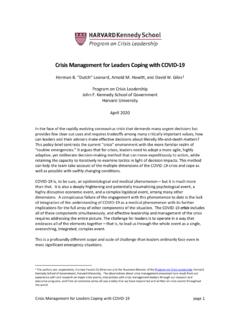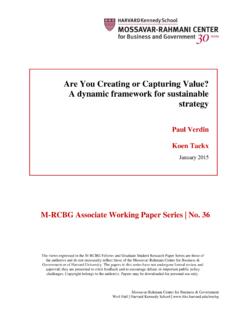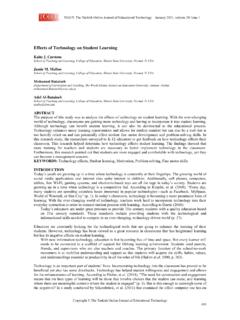Transcription of Systems Leadership - Harvard Kennedy School
1 DISCUSSION PAPER Systems Leadership for Sustainable Development: Strategies for Achieving Systemic ChangeLisa Dreier, David Nabarro and Jane NelsonSystems Leadership for Sustainable Development: Strategies for Achieving Systemic ChangeWritten by Lisa Dreier, David Nabarro and Jane NelsonCover photos: World Economic Forum New Vision for Agriculture Initiative (upper left), Scaling Up Nutrition Movement (upper right), and Rich City Rides (below).Designed by Alison Beanland 2019 by the CR Initiative at the Harvard Kennedy SchoolSYSTEMS Leadership FOR SUSTAINABLE DEVELOPMENT 3 Executive Summary 4 Preface: A Tool for our Times 6I. Systems Leadership : An emerging approach for tackling complex challenges 7II. The Emergence of the Systems Leadership Concept 9 III.
2 Defining Systems Leadership 13IV. The CLEAR Framework for Leading Systems Change 17V. The Journey of Systems Leadership : The Aha! Moments 28VI. Mindsets and Behaviors of Individual Systems Leaders 35 VII. Mainstreaming Systems Leadership : The Way Forward 37 Annexes1. Frameworks for Systems Leadership and Systems Change 392. CLEAR Framework Self-Assessment Questions for Systems Leadership Initiatives 433. List of Reviewers 45 Endnotes 46 Contents4 Systems Leadership FOR SUSTAINABLE DEVELOPMENTS ystems Leadership is a set of skills and capacities that any individual or organization can use to catalyze, enable and support the process of Systems -level change.
3 It is comprised of three interconnected elements: The Individual: The skills of collaborative Leadership to enable learning, trust-building and empowered action among stakeholders who share a common goal The Community: The tactics of coalition building and advocacy to develop alignment and mobilize action among stakeholders in the system, both within and between organizations The System: An understanding of the complex Systems shaping the challenge to be addressedThe 2030 Sustainable Development Agenda includes 17 inter-related Sustainable Development Goals (SDGs), each representing complex Systems such as climate, food, health, cities with myriad stakeholders. Achieving progress on this agenda requires a departure from traditional top-down, hierarchical and linear approaches to implementing change.
4 Instead it requires innovative and adaptive approaches that engage broad networks of diverse stakeholders to advance progress toward a shared vision for systemic change. This approach is called Systems Leadership . Executive SummaryAddressing complex challenges through Systems changeSystems Leadership : A tool for our timesThe Key Elements of Systems LeadershipTHE SYSTEMTHE COMMUNITYSYSTEMSLEADERSHIP THE INDIVIDUALC omplexSystemsInsightCoalition-building and advocacy TacticsCollaborative LeadershipSkillsSYSTEMSLEADERSHIP213 The CLEAR Framework for Leading Systems Change describes five key elements of the Systems change process. These are not necessarily sequential they may overlap or repeat in cycles throughout the course of an Convene and Commit Key stakeholders engage in moderated dialogue to address a complex issue of mutual concern.
5 They define shared interests and goals, and commit to working together in new ways to create systemic change. 2. Look and Learn Through system mapping, stakeholders jointly build a shared understanding of the components, actors, dynamics, and influences that create the system and its current outcomes, generating new insights and Engage and Energize Diverse stakeholders are engaged through continuous communication to build trust, commitment, innovation and collaboration. Inspiration, incentives and milestones help drive progress and maintain momentum. 4. Act with Accountability Shared goals and principles set the direction of the initiative, while measurement frameworks help track progress. Coordination and governance structures can be developed as initiatives mature.
6 5. Review and Revise Stakeholders review progress regularly and adapt the initiative strategy accordingly. Adopting an agile, flexible, innovative and learning-centered approach allows for evolution and experimentation. The CLEAR Framework for Leading Systems ChangeSYSTEMS Leadership FOR SUSTAINABLE DEVELOPMENT 5 That s our North Star The group agrees on a shared goal or vision to guide and align their We ll find a way Challenges and setbacks can spur innovation and We re in it together, for the long haul Reaffirming commitment and evolving to meet changing needs enables long-term success. I can make a difference One person, organization or small group can have significant We need coordination As the initiative grows, a coordinating team or Secretariat is often Wow!
7 Change is happening Demonstrating and celebrating progress helps maintain No one is in control No single entity has authority over the entire It s up to us Stakeholders recognize a collective responsibility to address the challenge Everything is Connected Collective mapping and learning about the system generates new To Go Far, Go Together Engaging and securing buy-in from a wide array of stakeholders is Journey of System Leadership : The Aha! MomentsParticipants in Systems -change initiatives often describe the experience as a collective journey of discovery that evolves over time. Many stakeholders encounter similar experiences, which often crystallize in an Aha! Moment a new insight that describes the dynamics at a given moment in the journey, such as those described Systems LeadershipThe Systems Leadership approach is still in an early stage of development.
8 Greater alignment and collaboration is needed among relevant experts and practitioners to enable broader access to and adoption of the approach. Additional investments and partners are needed to research and evaluate existing initiatives; disseminate insights on good practices; expand capacity-building training and tools; and strengthen Leadership Systems Leadership is not yet widely practiced, it offers a potentially valuable tool for addressing the complexity, dynamism and scale of the multi-dimensional challenges underlying the SDGs. As such, it shows great promise as a tool for advancing the 2030 Agenda for Sustainable SUMMARY6 Systems Leadership FOR SUSTAINABLE DEVELOPMENTThe Systems Leadership approach is well-suited to complex challenges that require collective action, where no single entity is in control.
9 It involves building and mobilizing alliances of diverse stakeholders around a shared vision for systemic change, empowering widespread collaboration, innovation and action; and enabling mutual accountability for progress to shift Systems towards Systems Leaders, which can include both individuals and institutions, serve as catalysts and enablers of this process a role requiring optimism, flexibility and endurance, along with the ability to understand and empower stakeholders with very different viewpoints and incentives. While the concept of Systems Leadership makes intuitive sense to many stakeholders, it is not yet widely embraced and practiced. Mainstreaming its application will require a broader and more coordinated effort to develop research, share knowledge and build capacity.
10 Platforms for exchanging knowledge and experiences among Systems Leadership practitioners are needed to share and accelerate paper contributes toward that broader goal by offering concepts, examples and tools of Systems Leadership to professionals from multiple sectors who are working to advance sustainable development. It seeks to link and synthesize existing experiences in diverse sectors and geographies. It is informed by the practical experiences of the authors in building a variety of multi-stakeholder coalitions at global, regional and national level across varied sectors including health, nutrition, agriculture, environment and energy. It also draws on interviews, case examples and literature reviews, suggesting ways in which Systems Leadership approaches can usefully be applied to complex challenges in sustainable development.













